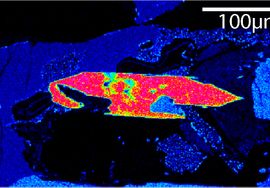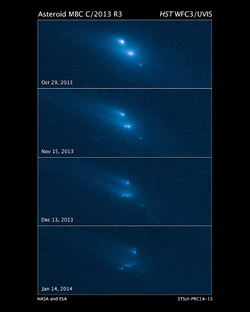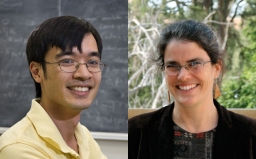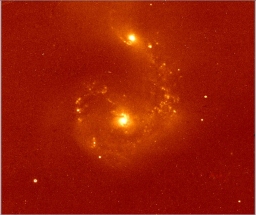The Press Room highlights computational astronomy work around the UC-HiPACC consortium; the wording of the short summaries on this page is based on wording in the individual releases or on the summaries on the press release page of the original source. Press releases below appear in reverse chronological order (most recent first); they can also be displayed by UC campus or DOE lab by clicking on the desired venue at the bottom of the left-hand column.
November 3, 2014 — UCLA astronomers solve puzzle about bizarre object at the center of our galaxy
_mid.jpg)
Telescopes at the Keck Observatory use adaptive optics, which enabled UCLA astronomers to discover that G2 is a pair of binary stars that merged together. Credit: Ethan Tweedie
July 29, 2014 — Mercury’s magnetic field tells scientists how its interior is different from Earth’s

Mercury, with colors enhanced to emphasize the chemical, mineralogical and physical differences among the rocks that make up its surface. Credit: NASA
August 5, 2014 — Construction to begin in Hawaii on world’s most advanced telescope

TMT at night, artist’s conception. Credit: www.tmt.org
April 1, 2014 — Misleading mineral may have led to overestimate of water in moon

Credit:UCLA
March 10, 2014 — Possible evidence for dark matter particle presented at UCLA physics symposium

Mysterious dark matter makes up approximately 26 percent of the mass of the universe. At a major UCLA symposium attended by 190 scientists, physicists presented several analyses that participants interpreted to imply the existence of a dark matter particle. Credit: NASA/Hubble
March 6, 2014 — Astronomers witness mysterious, never-before-seen disintegration of asteroid

This series of Hubble Space Telescope images reveals the breakup of an asteroid over a period of several months in late 2013.
January 13, 2014 — World's most powerful planet-finder turns skyward with help from UCLA astronomers. First of 3 releases about GPI.

GPI's image of dust disk orbiting HR4796A
Read full UCLA press release
December 18, 2013 — Scientists solve a decades-old mystery in the Earth's upper atmosphere

Schematic illustration of electron acceleration by “chorus”
View full UCLA press release
November 21, 2013 — Evidence of jet of high-energy particles from Milky Way’s black hole found by astronomers

Sagittarius A* in the center of the Milky Way galaxy
View full UCLA press release.
September 26, 2013 — Lunar orbiters discover source of space weather near Earth

Process of magnetic reconnection, which powers the phenomena known as space weather.
view full UCLA Press Release
September 22, 2013 — UCLA scientists explain the formation of unusual ring of radiation in space

Model showing third radiation ring (red)
view full UCLA Press Release
August 1, 2013 — Mission to build world's most advanced telescope reaches major milestone

Artist's rendering of Thirty Meter Telescope
view full UCLA Press Release
June 30, 2013 — How did a third radiation belt appear in the Earth's upper atmosphere?

NASA's Van Allen probes
view full UCLA Press Release
April 22, 2013 — UCLA space scientists find way to monitor elusive collisions in space

Christopher T. Russell
view full UCLA Press Release
October 4, 2012 — UCLA astronomers discover star racing around black hole at center of our galaxy

Keck telescopes observe the center of our galaxy
UCLA astronomers report the discovery of a remarkable star that orbits the enormous black hole at the center of our Milky Way galaxy in a blistering 11-and-a-half years — the shortest known orbit of any star near this black hole.
The star, known as S0-102, may help astronomers discover whether Albert Einstein was right in his fundamental prediction of how black holes warp space and time, said research co-author Andrea Ghez, leader of the discovery team and a UCLA professor of physics and astronomy who holds the Lauren B. Leichtman and Arthur E. Levine Chair in Astrophysics.
The research is published Oct. 5 in the journal Science.
view full UCLA Press Release
October 24, 2012 — Astronomers report dark matter 'halos' may contain stars, disprove other theories

The image on the left shows a portion of our sky, called the Boötes field, in infrared light, while the image on the right shows a mysterious, background infrared glow captured by NASA's Spitzer Space Telescope in the same region of sky. Using Spitzer, researchers were able to detect this background glow, which spreads across the whole sky, by masking out light from galaxies and other known sources of light.
Could it be that dark matter "halos" — the huge, invisible cocoons of mass that envelop entire galaxies and account for most of the matter in the universe — aren't completely dark after all but contain a small number of stars? Astronomers from UCLA, UC Irvine and elsewhere make a case for that in the Oct. 25 issue of the journal Nature.
Astronomers have long disagreed about why they see more light in the universe than it seems they should — that is, why the infrared light they observe exceeds the amount of light emitted from known galaxies.
When looking at the cosmos, astronomers have seen what are neither stars nor galaxies nor a uniform dark sky but mysterious, sandpaper-like smatterings of light, which UCLA's Edward L. (Ned) Wright refers to as "fluctuations." The debate has centered around what exactly the source of those fluctuations is.
view full UCLA Press Release
October 31, 2012 — Protoplanet Vesta: Forever young?

This image from NASA's Dawn spacecraft features the distinctive crater Canuleia on the protoplanet Vesta. Canuleia, about 6 miles (10 kilometers) in diameter, is distinguished by the rays of bright material that streak out from it.
Like a movie star constantly retouching her makeup, the protoplanet Vesta is continually stirring its outermost layer and presenting a young face.
New data from NASA's Dawn mission show that a common form of weathering that affects many airless bodies like Vesta in the inner solar system, including the moon, surprisingly doesn't age the protoplanet's outermost layer.
The data also indicate that carbon-rich asteroids have been splattering dark material on Vesta's surface over a long span of the body's history.
view full UCLA Press Release
July 18, 2012 — Astronomers using the Hubble Space Telescope report the earliest spiral galaxy ever seen

Galaxy BX442 and its companion dwarf galaxy.
Astronomers have witnessed for the first time a spiral galaxy in the early universe, billions of years before many other spiral galaxies formed. In findings reported July 19 in the journal Nature, the astronomers said they discovered it while using the Hubble Space Telescope to take pictures of about 300 very distant galaxies in the early universe and to study their properties. This distant spiral galaxy is being observed as it existed roughly three billion years after the Big Bang, and light from this part of the universe has been traveling to Earth for about 10.7 billion years.
"As you go back in time to the early universe, galaxies look really strange, clumpy and irregular, not symmetric," said Alice Shapley, a UCLA associate professor of physics and astronomy, and co-author of the study. "The vast majority of old galaxies look like train wrecks. Our first thought was, why is this one so different, and so beautiful?"
Galaxies in today’s universe divide into various types, including spiral galaxies like our own Milky Way, which are rotating disks of stars and gas in which new stars form, and elliptical galaxies, which include older, redder stars moving in random directions. The mix of galaxy structures in the early universe is quite different, with a much greater diversity and larger fraction of irregular galaxies, Shapley said...
view full UCLA Press Release
July 05, 2012 — Astronomers discover Houdini-like vanishing act in space

Dust today, gone tomorrow. Lynette Cook
Astronomers report a baffling discovery never seen before: An extraordinary amount of dust around a nearby star has mysteriously disappeared.
"It's like the classic magician's trick — now you see it, now you don't," said Carl Melis, a postdoctoral scholar at UC San Diego and lead author of the research. "Only in this case, we're talking about enough dust to fill an inner solar system, and it really is gone!"
"It's as if the rings around Saturn had disappeared," said co-author Benjamin Zuckerman, a UCLA professor of physics and astronomy. "This is even more shocking because the dusty disc of rocky debris was bigger and much more massive than Saturn's rings. The disc around this star, if it were in our solar system, would have extended from the sun halfway out to Earth, near the orbit of Mercury."
The research on this cosmic vanishing act, which occurred around a star some 450 light years from Earth, in the direction of the constellation Centaurus, appears July 5 in the journal Nature.
"A perplexing thing about this discovery is that we don't have a satisfactory explanation to address what happened around this star," said Melis, a former UCLA astronomy graduate student. "The disappearing act appears to be independent of the star itself, as there is no evidence to suggest that the star zapped the dust with some sort of mega-flare or any other violent event."...
view full UCLA Press Release
May 10, 2012 — You're beautiful, Vesta

Craters on Vesta
When UCLA's Christopher T. Russell looks at the images of the protoplanet Vesta produced by NASA's Dawn mission, he talks about beauty as much as he talks about science.
"Vesta looks like a little planet. It has a beautiful surface, much more varied and diverse than we expected," said Russell, a professor in UCLA's Department of Earth and Space Sciences and the Dawn mission's principal investigator. "We knew Vesta's surface had some variation in color, but we did not expect the diversity that we see or the clarity of the colors and textures, or their distinct boundaries. We didn't find gold on Vesta, but it is still a gold mine."
Dawn has been orbiting Vesta and collecting data on the protoplanet's surface since July 2011. Vesta, which is in the doughnut-shaped asteroid belt between Mars and Jupiter, is currently some 321 million miles from Earth.
The journal Science publishes six papers about Vesta on May 11. Russell is a co-author on all of them...
view full UCLA Press Release
May 09, 2012 — UCLA's Andrea Ghez, Terence Tao elected to American Philosophical Society

Tao (left) and Ghez
Renowned UCLA scientists Andrea Ghez, a professor of physics and astronomy, and Terence Tao, a professor of mathematics, have been elected to the American Philosophical Society, the country's oldest learned society, which recognizes extraordinary achievements in science, letters and the arts.
Founded in 1743 by Benjamin Franklin, the society's members have included George Washington, John Adams, Thomas Jefferson, James Madison, Charles Darwin, Marie Curie, Albert Einstein, Thomas Edison, Louis Pasteur, Linus Pauling and Margaret Mead.
Next week, Ghez and Tao will be in Lund, Sweden, for another honor: Each will receive the Royal Swedish Academy of Sciences' prestigious Crafoord Prize in the presence of the king and queen of Sweden. The prize recognizes extraordinary achievements in mathematics, astronomy and other fields.
Joseph Rudnick, dean of the UCLA Division of Physical Sciences, has called Ghez and Tao "two of UCLA's true superstars — indeed, two of the world's intellectual superstars."...
view full UCLA Press Release
April 11, 2012 — 'Time machine' will study the early universe

MOSFIRE image of colliding Atennae galaxies
By Stuart Wolpert
A new scientific instrument, a "time machine" of sorts, built by UCLA astronomers and colleagues, will allow scientists to study the earliest galaxies in the universe, which could never be studied before.
The five-ton instrument, the most advanced and sophisticated of its kind in the world, goes by the name MOSFIRE (Multi-Object Spectrometer for Infra-Red Exploration) and has been installed in the Keck I Telescope at the W.M. Keck Observatory atop Mauna Kea in Hawaii.
MOSFIRE gathers light in infrared wavelengths — invisible to the human eye — allowing it to penetrate cosmic dust and see distant objects whose light has been stretched or "redshifted" to the infrared by the expansion of the universe.
"The instrument was designed to study the most distant, faintest galaxies," said UCLA physics and astronomy professor Ian S. McLean, project leader on MOSFIRE and director of UCLA's Infrared Laboratory for Astrophysics. "When we look at the most distant galaxies, we see them not as they are now but as they were when the light left them that is just now arriving here. Some of the galaxies that we are studying were formed some 10 billion years ago — only a few billion years after the Big Bang. We are looking back in time to the era of the formation of some of the very first galaxies, which are small and very faint. That is an era that we need to study if we are going to understand the large-scale structure of the universe."
With MOSFIRE, it will now become much easier to identify faint galaxies, "families of galaxies" and merging galaxies. The instrument also will enable detailed observations of planets orbiting nearby stars, star formation within our own galaxy, the distribution of dark matter in the universe and much more...
view full UCLA Press Release